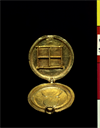Description
The faith of Sergios carries the venerable receptacle of Demetrios’ blood together with the balm. He asks to have you as protector, while he is living, and when he is dead, along with the two martyrs who have won the prize.
According to its inscription, this pendant reliquary once contained both the blood of the fourth-century soldier martyr Demetrios of Thessaloniki, and his balm, a miraculous perfumed oil that flowed from a fountain at the Church of Saint Demetrios in Thessaloniki. On the cover, the saint wears armor and bears a shield. These attributes, combined with the presence on the reverse of two other soldier martyrs mentioned in the inscription, Sergios and Bacchos, suggest that the owner, also named Sergios, may have been a military man and may have invoked Demetrios’s special protection in battle. Indeed, many of the posthumous sightings of the saint had occurred among soldiers fighting battles in Thessaloniki in the seventh century.
On the inside of the reliquary, two doors open to reveal a tiny relief of the Saint, reclining under an arch or dome, dressed not in armor, but in the long chlamys of the aristocrat. This concealed image refers to other miraculous appearances of Demetrios at his shrine. Even in the early history of his cult, there seems to have been some uncertainty as to the exact whereabouts of his remains. His miracles tended to occur, then, not around the church’s crypt, but in a little domed structure in the nave called the ciborion, inside of which he was seen in visions sitting or reclining on a couch. The witnesses often recognized the saint because he was dressed as he was in his icons. Such stories reveal, as does the little effigy inside this reliquary, the intimate connection between visual and spiritual perception in Byzantium.
- J. Hanson
Bibliography
O. M. Dalton, "Reliquary in the British Museum," The British Museum Quarterly 1.2 (1926): 33-35.
A. Grabar, "Un nouveau reliquaire de saint Démétrios," Dumbarton Oaks Papers 8 (1954): 307-13.
The Dumbarton Oaks Collection, Harvard University (Washington, D.C., 1955), 141, 143, pl. 282, color frontispiece.
V. Laurent, "The Dumbarton Oaks Collection, Harvard University, Washington (review)," 14 (1956): 298-300, esp. 300.
M. C. Ross, Jewelry, Enamels, and Art of the Migration Period, Catalogue of the Byzantine and Early Mediaeval Antiquities in the Dumbarton Oaks Collection 2 (Washington, D.C., 1965, 2nd ed. with addendum by S.A. Boyd and S. R. Zwirn, 2005), 111-112, no. 160, pl. 74, 75, colorpl. H.
Handbook of the Byzantine Collection (Washington, D.C., 1967), 73-74, no. 262.
K. Wessel, Die byzantinische Emailkunst vom 5. bis 13. Jahrhundert, Beiträge zur Kunst des christlichen Ostens 4 (Recklinghausen, 1967, Byzantine Enamels from the 5th to the 13th Century, trans. Irene R. Gibbons, Greenwich, Conn., New York Graphic Society 1967
), 192, no. 62.
R. Prior, D. Buckton, C. Entwistle, and M. Carrieri, The Treasury of San Marco, Venice, exhibition catalogue, Metropolitan Museum of Art, (Milan, 1984), 170, fig. 18a.
D. Buckton, "'All that Glisters...' Byzantine Enamel on Copper," in Thymiama: Ste Mneme tes Laskarinas Boura (Athens, 1994), 47-49, pl. 20.6.
H. C. Evans and W. D. Wixom, The Glory of Byzantium : Art and Culture of the Middle Byzantine Era, A.D. 843-1261, exhibition catalogue, Metropolitan Museum of Art, March 11-July 6, 1997 (New York, 1997), 168, no. 117.
D. Papanikola-Bakirtze, Everyday Life in Byzantium, exhibition catalogue, Thessaloniki, Museum of Byzantine Culture, (Athens, 2002), no. 202.
A. Weyl Carr, "Icons and the Object of Pilgrimage in Middle Byzantine Constantinople," Dumbarton Oaks Papers 56 (2002): 75-92, fig. 7a-b.
G. Bühl, ed., Dumbarton Oaks: The Collections (Washington, D.C., 2008), 168, pl. p. 169.
C. J. Hahn, M. Bagnoli, D. Krueger, and H. A. Klein, Treasures of Heaven: Saints, Relics, and Devotion in Medieval Europe, exhibition catalogue, Cleveland Museum of Art; Walters Art Museum; The British Museum, October 17, 2010 - October 9, 2011, (Cleveland, Ohio; Baltimore; London; New Haven, Conn., 2010), 45-46, no. 29.
F. A. Bauer, Eine Stadt und ihr Patron: Thessaloniki und der Heilige Demetrios, Thessaloniki und der Heilige Demetrios, 1. Aufl. ed. (Regensburg, 2013), 374, fig. 28.
Exhibition History
New York, The Metropolitan Museum of Art, "The Glory of Byzantium: Art and Culture of the Middle Byzantine Era, A.D. 843-1261," March 11 - July 6, 1997.
Thessaloniki, White Tower Museum, "Byzantine Hours," Oct. 21, 2001 - Jan.10, 2002.
"Treasures of Heaven: Saints, Relics, and Devotion in Medieval Europe," Cleveland Museum of Art, October 17, 2010 - January 17, 2011; Walters Art Museum, Baltimore, February 13, 2011 - May 15, 2011; British Museum, London, June 23, 2011 - October 9, 2011.
Washington, DC. Dumbarton Oaks, 75 Years/75 Objects: Celebrating 75 Years of the Dumbarton Oaks Museum, September 8, 2015 - May 22, 2016.








